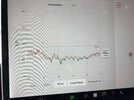Nice one @ittah Mine, which is essentially the same car in the same location and climate looks like this.

This might suggests driving style and where we drive has a fair bit to do with it. Predominantly country driving for me. @ittah is your driving somewhat focused on urban areas perhaps? They both show similar negative effects of temperature extremes though. Just that you are markedly more efficient. Be interesting to see what your lifetime average speed is? Mine is 75KMH. Telsafi does not show this figure directly, but if you go to Lifetime map and look in the top line it displays kms driven and "Times spent driving" in days & hours. Convert the latter to hours & divide km driven by this figure.
This might suggests driving style and where we drive has a fair bit to do with it. Predominantly country driving for me. @ittah is your driving somewhat focused on urban areas perhaps? They both show similar negative effects of temperature extremes though. Just that you are markedly more efficient. Be interesting to see what your lifetime average speed is? Mine is 75KMH. Telsafi does not show this figure directly, but if you go to Lifetime map and look in the top line it displays kms driven and "Times spent driving" in days & hours. Convert the latter to hours & divide km driven by this figure.



